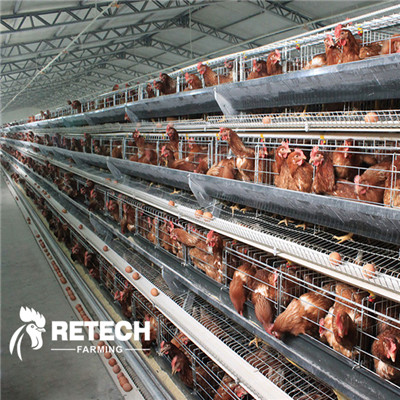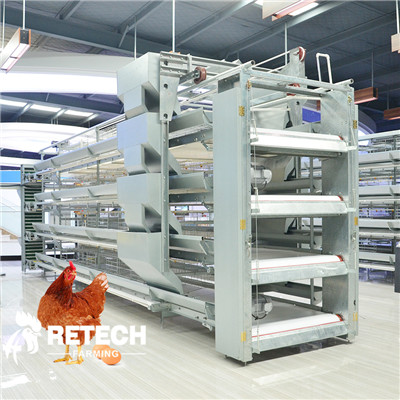Tavuk yetiştirmenin genellikle iki yolu vardır: serbest gezen tavuklar ve kafes tavukları. Çoğu yumurta tavuğu çiftliği, yalnızca arazi kullanımını iyileştirmekle kalmayıp aynı zamanda besleme ve yönetimi de kolaylaştıran kafes yöntemlerini kullanır. Elle yumurta toplama işleminin verimliliğini artırır.
Peki yumurta tavuklarını kafeslere koyarken nelere dikkat etmeliyiz?
1. Kafesin yaşı
En iyi yaşyumurta tavuklarıGenellikle on üç haftalık ile on sekiz haftalık yaş arasındadır. Bu, genç yumurtacı tavukların ağırlığının normal standartların altında olmasını en iyi şekilde sağlayabilir ve aynı zamanda üreme sürecinde yumurta üretim oranını artırabilir.
Dikkat etmemiz gereken nokta, en son kafese yerleştirme zamanının 20 haftalık yaştan sonra olmamasıdır; ayrıca tavukların iyi gelişmeleri halinde 60 günlük olduklarında da kafes vidalamaya devam edebiliriz.
Kafesleri doldururken, kafesleri farklı büyüme koşullarına göre gruplar halinde gruplandırmamız ve doldurmamız da gerekiyor.yumurta tavukları.
2. Tesisler ve ekipmanlar
Yumurta tavuğu kafese konulduktan sonra bile, orijinal büyüme ortamını sağlamamız gerekir; aksi takdirde büyümesi ve üretimi de etkilenir. Kafesleri yüklemeden önce, uygun üreme ekipmanlarıyla donatılmalı ve çeşitli üreme tesisleri kurulmalıdır; ayrıca, daha sonraki üreme sürecinde sorun yaşamamak için bu tesis ve ekipmanların sıkı bir şekilde elden geçirilmesi ve yenilenmesi gerekir.
3. Tavukları bilimsel olarak yakalayın
Yumurta tavuklarını kafeslere koyarken bilimsel olmalı, hareket çok büyük olmamalı, el ve ayaklar hafif olmalı ve kuvvet çok güçlü olmamalıdır. Üretim üzerindeki etkisi çok büyüktür.
Genel olarak strese giren tavuklarda iştah azalması, sonrasında ise giderek zayıflama görülür ve bu durum sürünün sağlığını ciddi şekilde etkiler.
4. Vaka sayısının artmasını önlemek için
Operasyonuyumurta tavuklarıKafesi yüklerken sıcaklık değerlerinin doğru olmasına dikkat edilmeli, kafes yüklendikten sonra sıcaklık farkının değişimine dikkat edilmeli ve sıcaklık makul bir şekilde kontrol edilmelidir.
Gece kafesleme yapmak, kafesleme sonrası beslemeyi iyileştirmek, besin dengesi sağlanmış yemleri makul şekilde ayarlamak ve kimyasal kontrolü bilimsel olarak yapmak en iyisidir; bu, bazı hastalıkların oluşumunu önleyebilir ve yumurtacı tavukların kalitesini artırabilir.
5. Parazitlerin önlenmesi ve kontrolü
Yumurta tavuklarının sağlığını ve daha sonraki üretimlerini garanti altına almak için onları solucanlardan arındırmamız gerekir.
Özellikle yumurta tavukları 60 günlük ve 120 günlük olduğunda, yani kafese konduğumuzda, kafesleri doldururken, parazitlerin önlenmesi ve kontrolü için bilimsel talimatlara uygun olarak solucan ilacı vermeliyiz.
6. Sürüyü nispeten istikrarlı tutun
Tavuk sürüsünü nispeten istikrarlı tutmak aslında çok basittir, yani mümkün olduğunca aynı kümeste ve aynı çemberde bulunan tavuk sürülerinin kafeslenmesidir.
Normal şartlarda, tanımadıkları tavuklar yeni bir ortama girdiklerinde, yem, su ve yer kapma mücadelesi olgusu ortaya çıkar ki bu da yumurtacı tavukların verimini büyük ölçüde etkiler, bu nedenle bu durumdan kaçınmak en iyisidir.
Yukarıdaki önlemler şunlardır:kafeslenmişYumurta tavukları. İşletme sırasında sürüyü rahatsız etmekten kaçınmalı, yakalama yöntemine dikkat etmeli ve çok fazla güç kullanmamalıyız. Kafesi gece kurmak en iyisidir. Kafes kurulduktan sonra, yumurta tavuklarının gelişimini etkilememek için ekipmanların sıkı bakımına ve değişimine dikkat edilmelidir.
Gönderi zamanı: 14 Temmuz 2022









